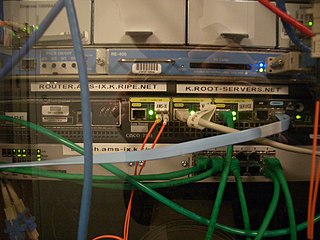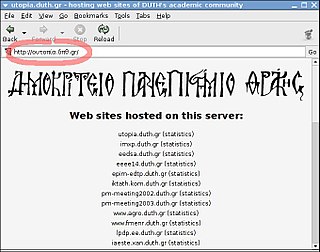Related Research Articles
The Domain Name System (DNS) is a hierarchical and distributed naming system for computers, services, and other resources in the Internet or other Internet Protocol (IP) networks. It associates various information with domain names assigned to each of the associated entities. Most prominently, it translates readily memorized domain names to the numerical IP addresses needed for locating and identifying computer services and devices with the underlying network protocols. The Domain Name System has been an essential component of the functionality of the Internet since 1985.

Janet is a high-speed network for the UK research and education community provided by Jisc, a not-for-profit company set up to provide computing support for education. It serves 18 million users and is the busiest National Research and Education Network in Europe by volume of data carried. Previously, Janet was a private, UK-government funded organisation, which provided the JANET computer network and related collaborative services to UK research and education.
A top-level domain (TLD) is one of the domains at the highest level in the hierarchical Domain Name System of the Internet after the root domain. The top-level domain names are installed in the root zone of the name space. For all domains in lower levels, it is the last part of the domain name, that is, the last non empty label of a fully qualified domain name. For example, in the domain name www.example.com, the top-level domain is .com. Responsibility for management of most top-level domains is delegated to specific organizations by the ICANN, an Internet multi-stakeholder community, which operates the Internet Assigned Numbers Authority (IANA), and is in charge of maintaining the DNS root zone.
In the Internet, a domain name is a string that identifies a realm of administrative autonomy, authority or control. Domain names are often used to identify services provided through the Internet, such as websites, email services and more. As of 2017, 330.6 million domain names had been registered. Domain names are used in various networking contexts and for application-specific naming and addressing purposes. In general, a domain name identifies a network domain or an Internet Protocol (IP) resource, such as a personal computer used to access the Internet, or a server computer.
UUCP is an acronym of Unix-to-Unix Copy. The term generally refers to a suite of computer programs and protocols allowing remote execution of commands and transfer of files, email and netnews between computers.

A root name server is a name server for the root zone of the Domain Name System (DNS) of the Internet. It directly answers requests for records in the root zone and answers other requests by returning a list of the authoritative name servers for the appropriate top-level domain (TLD). The root name servers are a critical part of the Internet infrastructure because they are the first step in resolving human-readable host names into IP addresses that are used in communication between Internet hosts.
An email address identifies an email box to which messages are delivered. While early messaging systems used a variety of formats for addressing, today, email addresses follow a set of specific rules originally standardized by the Internet Engineering Task Force (IETF) in the 1980s, and updated by RFC 5322 and 6854. The term email address in this article refers to just the addr-spec in Section 3.4 of RFC 5322. The RFC defines address more broadly as either a mailbox or group. A mailbox value can be either a name-addr, which contains a display-name and addr-spec, or the more common addr-spec alone.

An internationalized domain name (IDN) is an Internet domain name that contains at least one label displayed in software applications, in whole or in part, in non-latin script or alphabet or in the Latin alphabet-based characters with diacritics or ligatures. These writing systems are encoded by computers in multibyte Unicode. Internationalized domain names are stored in the Domain Name System (DNS) as ASCII strings using Punycode transcription.

.uk is the Internet country code top-level domain (ccTLD) for the United Kingdom. It was first registered in July 1985, seven months after the original generic top-level domains such as .com and the first country code after .us.

.gb is a reserved Internet country code top-level domain (ccTLD) for the United Kingdom, derived from Great Britain.
AlterNIC was an unofficial, controversial Internet domain name registry that relied on an alternative DNS root. The primary purpose of the project was to challenge the monopoly of InterNIC, the official governing body for generic top-level domains (gTLDs) until the creation of the ICANN in 1998. AlterNIC offered second level domain registration in its own TLDs at lower prices than InterNIC. However, these domain names could only be resolved by name servers that were specifically configured to use the AlterNIC root zone. The project is now defunct; the domain name alternic.net is parked and no longer associated with AlterNIC.
In the Domain Name System (DNS) hierarchy, a subdomain is a domain that is a part of another (main) domain. For example, if a domain offered an online store as part of their website example.com, it might use the subdomain shop.example.com.
The domain name arpa is a top-level domain (TLD) in the Domain Name System (DNS) of the Internet. It is used predominantly for the management of technical network infrastructure. Prominent among such functions are the subdomains in-addr.arpa and ip6.arpa, which provide namespaces for reverse DNS lookup of IPv4 and IPv6 addresses, respectively.
Forward-confirmed reverse DNS (FCrDNS), also known as full-circle reverse DNS, double-reverse DNS, or iprev, is a networking parameter configuration in which a given IP address has both forward (name-to-address) and reverse (address-to-name) Domain Name System (DNS) entries that match each other. This is the standard configuration expected by the Internet standards supporting many DNS-reliant protocols. David Barr published an opinion in RFC 1912 (Informational) recommending it as best practice for DNS administrators, but there are no formal requirements for it codified within the DNS standard itself.
The Coloured Book protocols were a set of communication protocols for computer networks developed in the United Kingdom in the 1970s. These protocols were designed to enable communication and data exchange between different computer systems and networks. The name originated with each protocol being identified by the colour of the cover of its specification document. The protocols were in use until the 1990s when the Internet protocol suite came into widespread use.
The following outline is provided as an overview of and topical guide to the Internet.
Reverse domain name notation is a naming convention for components, packages, types or file names used by a programming language, system or framework. Reverse-DNS strings are based on registered domain names, with the order of the components reversed for grouping purposes. For example, if a company making the product "MyProduct" has the domain name example.com, they could use the reverse-DNS string com.example.MyProduct as an identifier for that product. Reverse-DNS names are a simple way of eliminating namespace collisions, since any domain name is globally unique to its registered owner.

The United Kingdom has been involved with the Internet throughout its origins and development. The telecommunications infrastructure in the United Kingdom provides Internet access to businesses and home users in various forms, including fibre, cable, DSL, wireless and mobile.
DNS hijacking, DNS poisoning, or DNS redirection is the practice of subverting the resolution of Domain Name System (DNS) queries. This can be achieved by malware that overrides a computer's TCP/IP configuration to point at a rogue DNS server under the control of an attacker, or through modifying the behaviour of a trusted DNS server so that it does not comply with internet standards.
The history of email entails an evolving set of technologies and standards that culminated in the email systems in use today.
References
- ↑ Wells, Mike (1988-11-01). "JANET-the United Kingdom Joint Academic Network". Serials. 1 (3): 28–36. doi: 10.1629/010328 . ISSN 1475-3308.
- 1 2 3 Houlder, Peter (January 19, 2007). "Starting the Commercial Internet in the UK" (PDF). 6th UK Network Operators' Forum. Retrieved 2020-02-12.
- 1 2 3 Reid, Jim (April 3, 2007). "Networking in UK Academia ~25 Years Ago" (PDF). 7th UK Network Operators' Forum. Archived from the original (PDF) on August 20, 2007. Retrieved 2020-02-12.
- ↑ The "Hidden" Prehistory of European Research Networking. Trafford Publishing. ISBN 978-1-4669-3935-6.
- 1 2 Mansell, Robin; Mansell, Dixons Chair in New Media and the Internet Interdepartmental Programme in Media and Communications Robin (2002). Inside the Communication Revolution: Evolving Patterns of Social and Technical Interaction. Oxford University Press. p. 208. ISBN 978-0-19-829656-0.
- ↑ Kirstein, P.T. (1999). "Early experiences with the Arpanet and Internet in the United Kingdom" (PDF). IEEE Annals of the History of Computing. 21 (1): 38–44. doi:10.1109/85.759368. ISSN 1934-1547. S2CID 1558618. Archived from the original (PDF) on 2020-02-07.
From the outset of the project, we aimed not only to carry out innovative research, but also to provide network services to UK and U.S. groups that wished to cooperate.
- ↑ "FLAGSHIP". Central Computing Department Newsletter (16). September 1991.
- ↑ Rutter (2005), p. 92
- ↑ "Janet(UK) Quarterly Report to the Janet Community: July 1997 to September 1997". Janet webarchive. 1997. Archived from the original on February 16, 2012.
- ↑ Milton Mueller (2002), Ruling the Root: Internet Governance and the Taming of Cyberspace, Cambridge, Massachusetts: MIT Press, p. 79, ISBN 978-0-262-63298-0
Sources
- Rutter, Dorian (2005). From Diversity to Convergence: British Computer Networks and the Internet, 1970-1995 (PDF) (Computer Science thesis). The University of Warwick.